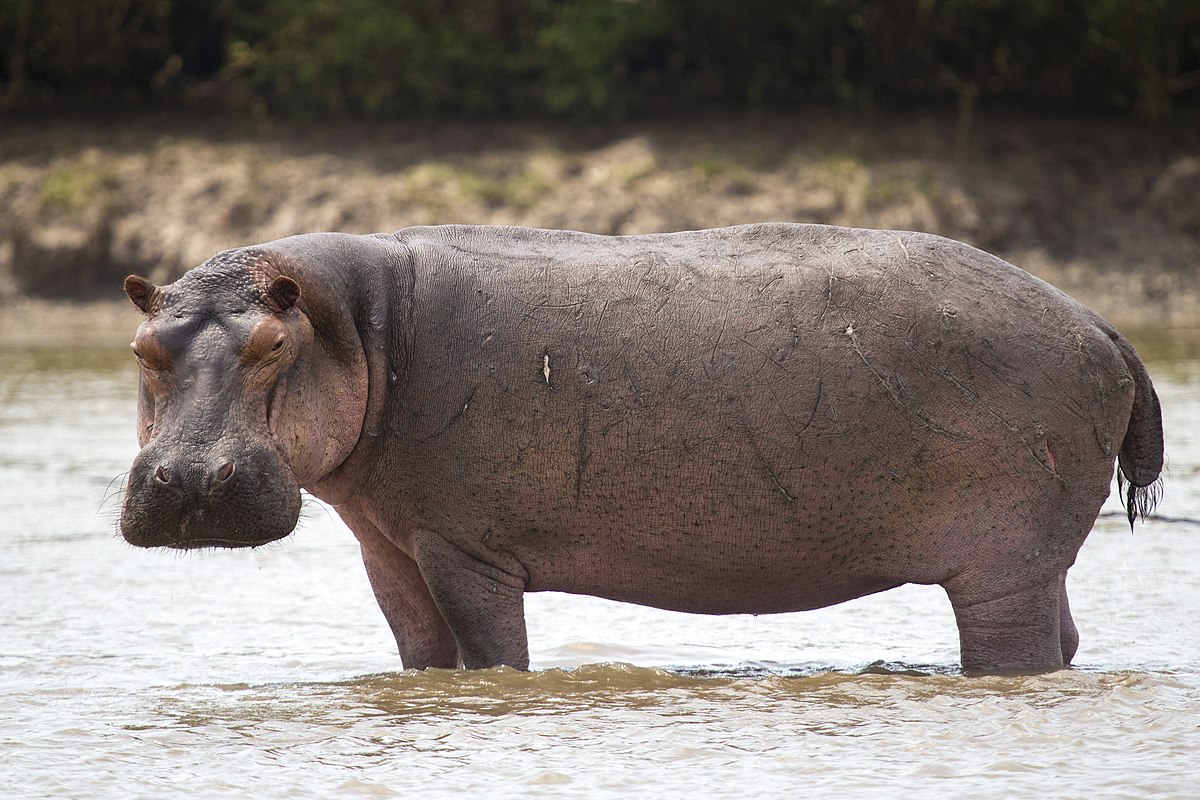Welcome to our blog post on Hippopotamus: History, Facts, Size, Habitat, and Classification! Today, we are going to dive into the fascinating world of these incredible creatures, sharing various interesting details about them. So, let’s get started and learn more about one of the most amazing animals on our planet.
The hippopotamus, often referred to as the “river horse,” is an extraordinary mammal that has been around for millions of years. These large, semi-aquatic creatures can be found in parts of Africa and are known for their hefty size and remarkable features. Despite their seemingly clumsy appearance, they are actually quite agile in water and can be surprisingly fast on land!
Hippopotamuses are herbivores, meaning they only eat plants; they have an enormous appetite and consume vast amounts of grass in a single day! They spend most of their time submerged in water, keeping cool and protecting their thick, hairless skin from the harsh sun. Due to their size and specific requirements, they inhabit rivers, lakes, and swamps, making these aquatic environments their ideal home. As we delve into this blog post, we will provide you with a detailed understanding of their history, intriguing facts, size measurements, natural habitat, and classification.
Join us on this exciting journey as we explore more about these remarkable creatures and uncover the wonders of the animal kingdom. Get ready to uncover some surprising and mesmerizing facts about the hippopotamus that will leave you awestruck! So, let’s dive right in and discover more about this magnificent animal. Enjoy reading and learning all about the fascinating world of hippopotamuses!
History of Hippopotamus
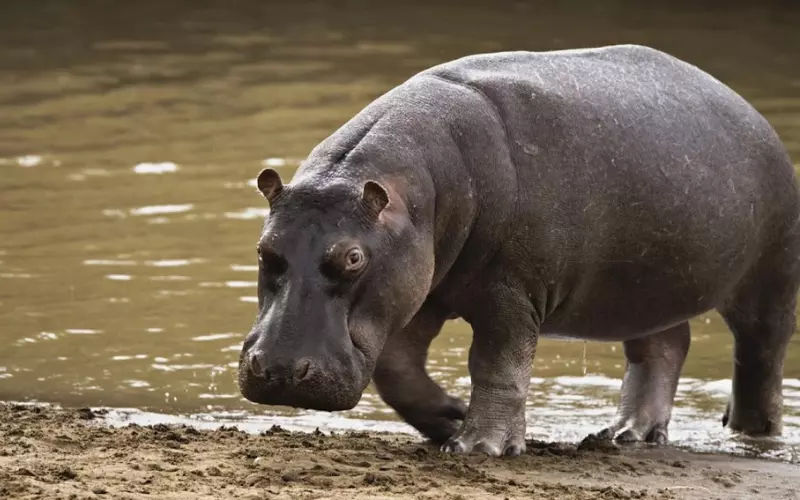
The history of the hippopotamus dates back to millions of years. These large mammals originated in Africa and are believed to be one of the oldest species on our planet. The name “hippopotamus” comes from Greek words meaning “river horse,” as they spend a lot of time in the water.
In ancient times, hippos were revered and feared by humans. In Egypt, they were seen as sacred animals and were associated with the goddess of fertility and childbirth. Egyptians also believed that hippos had protective qualities and represented rebirth. Many images and statues of hippos have been found in ancient Egyptian tombs.
During the colonial era, hippos faced a significant threat. They were hunted and slaughtered for their meat, skin, and ivory teeth. Many were captured and taken to zoos around the world, where they were put on display for the public. This resulted in a decline in their population, and they became an endangered species.
In recent years, efforts have been made to protect and conserve hippos. They are now listed as a vulnerable species, and various organizations are working to ensure their survival. National parks and reserves have been established in Africa to provide a safe habitat for these magnificent creatures.
Although hippos may appear docile, they are considered one of the most dangerous animals in Africa. They are responsible for more human deaths than any other mammal on the continent. Despite this, hippos are an essential part of the African ecosystem, and their presence is crucial for maintaining the balance of aquatic environments.
The history of the hippopotamus stretches back to ancient times when they were revered and feared. They faced threats during the colonial era but are now being protected and conserved. These magnificent creatures play a vital role in the African ecosystem and continue to captivate our curiosity and admiration.
Importance of Hippopotamus
The hippopotamus is an important animal in our world. This large mammal can teach us many things about nature and help to keep our ecosystems balanced. It is vital for us to understand the importance of the hippopotamus and to protect its existence.
One reason why the hippopotamus is important is because it plays a crucial role in maintaining the health of our ecosystems. They are often called “ecosystem engineers” because they create and maintain habitats for many other organisms. Their large bodies help to shape the landscape by creating wallows and paths, which in turn provide water sources for other animals. Without the hippopotamus, the ecosystem would suffer and many other animals would not have a suitable home.
Secondly, hippos are essential for the nutrient cycle in their environments. When they eat vegetation, they digest only a small portion of it, and the rest is released back into the ecosystem as their waste. This waste serves as a fertilizer for plants in the water, helping them to grow and providing food for other animals. In this way, hippos contribute to the overall health of the ecosystem by ensuring that nutrients are recycled properly.
Lastly, hippos have cultural significance in various societies. In some African countries, they are considered sacred animals and are associated with protection and fertility. They also play a role in local economies through wildlife tourism, attracting visitors who want to observe and learn about these amazing animals. Preserving the hippopotamus is not only important for the health of our environment, but it also helps to protect the cultural heritage and livelihoods of many communities.
The hippopotamus is an important animal that contributes to the balance of our ecosystems, helps with nutrient recycling, and holds cultural significance in various societies. Therefore, we must do our part to protect and conserve this incredible creature for the benefit of ourselves, our environment, and future generations.
Amazing Facts About Hippopotamus
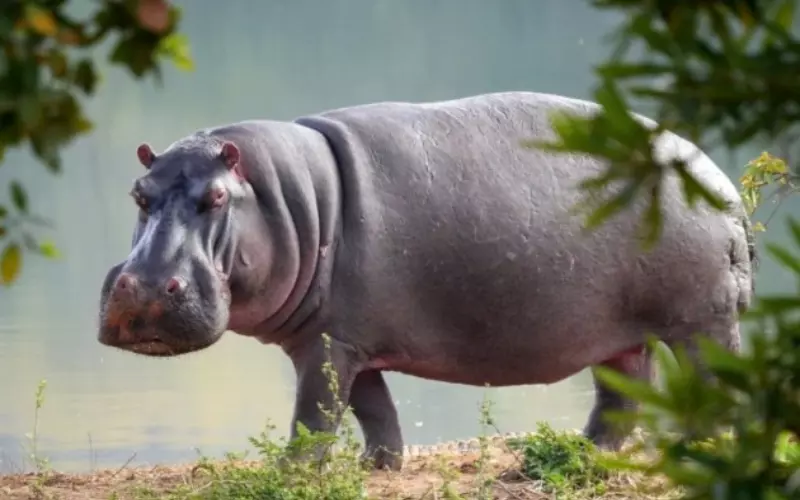
1. Hippos are large, semi-aquatic mammals that live in sub-Saharan Africa, mainly occupying rivers, lakes, and swamps.
2. They are among the heaviest land animals, with males weighing up to 3,500 kilograms (7,716 pounds) and females around 1,500 to 1,800 kilograms (3,307 to 3,968 pounds).
3. Hippos have a barrel-shaped body, short legs, and webbed toes, which allow them to move swiftly in water.
4. Despite their massive size, hippos are herbivores, feeding primarily on grasses. They consume around 40 kilograms (88 pounds) of vegetation each night.
5. These mammals have a unique skin texture that secretes a red fluid, commonly known as “hippo sweat,” acting as a natural sunscreen and moisturizer.
6. Hippos are famous for their enormous jaws, which can open up to 150 degrees, revealing their long, sharp canine teeth up to 50 centimeters (20 inches) in length.
7. They are highly territorial and can become aggressive, especially during the mating season. Hippos are responsible for more human deaths in Africa each year than any other large animal.
8. Contrary to popular belief, hippos are not great swimmers; instead, they are buoyant and can walk or run along the riverbeds, reaching speeds of up to 30 kilometers per hour (18.6 mph).
9. Hippos spend most of their day resting in water to stay cool and avoid the harsh sun. However, they are also known to venture kilometers away from water at night to search for food.
10. These mammals are social animals and form communities consisting of females, their young, and a dominant male.
11. Hippos communicate through a series of vocalizations, such as grunts, roars, and clicks, often used to establish dominance or warn off intruders.
12. Their average lifespan in the wild is around 40 to 50 years, although some have been recorded to live up to 60 years.
13. Female hippos usually give birth to a single calf every two years. The young calf relies on its mother’s milk for the first eight months of its life.
14. Adult hippos have no natural predators, except for humans. However, young hippos can fall victim to crocodiles, lions, and hyenas.
15. Despite being vulnerable due to habitat loss and illegal hunting, hippos are considered keystone species and play a crucial role in maintaining the balance of aquatic ecosystems.
Can we keep a Hippopotamus as our Pet?
Keeping a hippopotamus as a pet is not a good idea for many reasons. First of all, hippos are wild animals that need lots of space and a specific habitat to thrive in. They are native to Africa and are best suited to live in rivers and lakes, where they can swim and find their food. They require a large amount of food each day, mainly consisting of grass and plants, which may not be readily available or affordable for most people to provide.
Furthermore, hippos are extremely large and powerful animals. A full-grown hippo can weigh up to 4,000 kilograms and reach a length of about 4 meters. Their size alone makes them unsuitable as pets, as they require specialized care and facilities. Hippos are also known for being aggressive and territorial. They can become very dangerous if they feel threatened or stressed, and their unpredictable behavior can pose a significant risk to both humans and other animals.
Lastly, hippos have specific needs and behaviors that are difficult to meet in a domestic setting. They are social animals and typically live in groups or “pods” in the wild. Isolating them from their natural environment and denying them the company of their own kind can significantly impact their well-being and mental health. It is essential to remember that animals should be treated with respect and provided with the conditions that allow them to live a happy and fulfilling life.
Due to their habitat requirements, large size, aggressive nature, and specific social needs, keeping a hippopotamus as a pet is not recommended. It is crucial to appreciate these magnificent creatures in their natural environment and to promote their conservation rather than attempting to domesticate them, as this can lead to negative consequences for both humans and the animals themselves.
Size of Hippopotamus
The hippopotamus is a big and fascinating animal that can be found in Africa. It is one of the largest land mammals in the world. Usually, they measure around 13 to 16 feet long and can weigh between 3,000 to 4,000 pounds. That’s about the same weight as a small car!
These incredible creatures have a massive body with short legs. They have a big head, a broad snout, and really huge jaws with sharp teeth. Unlike most other mammals, hippopotamuses have special adaptations that allow them to spend a lot of time in the water. Their eyes, ears, and nostrils are located on the top of their heads so they can still see, hear, and breathe while their bodies are mostly below the water’s surface.
Even though hippos are super heavy, they are remarkably swift on land and in the water. They can run up to 20 miles per hour and can easily outswim a human. Despite their large size, they are herbivores, meaning they eat plants. They often graze on grasses at night and can consume up to 80 pounds of vegetation in just one day!
The hippopotamus is an enormous animal that lives in Africa. It measures around 13 to 16 feet long and weighs about 3,000 to 4,000 pounds, making it one of the largest land mammals. With a massive body, short legs, and sharp teeth, it has unique adaptations that allow it to spend time both on land and in the water. Even though it is a heavy herbivore, it is surprisingly fast and can run up to 20 miles per hour.
Habitat of Hippopotamus
The hippopotamus calls Africa its home. It can be found in various parts of this vast continent, such as the rivers, lakes, and swamps. These large and gentle creatures love to spend most of their time submerged in water, as it provides a cool refuge from the scorching African heat. The rivers and lakes give them easy access to water, which is essential for their survival.
Hippos prefer to live in areas with a slow-moving water source, like a river or a lake. They are known to create their own paths in the water, creating channels that allow them to navigate through their habitat. The water also serves as a protective barrier against predators, as hippos are excellent swimmers and can stay submerged for long periods of time. Additionally, these bodies of water offer an abundant supply of aquatic plants, which make up the majority of a hippo’s diet.
Besides the water, hippos also require large open spaces nearby for grazing. After sunset, they venture out of the water in search of grassy plains, floodplains, or even dense forests to feed on. They can consume massive amounts of grass, around 40 kilograms per night, which helps them maintain their bulky bodies. Due to their size and weight, hippos often leave trails or pathways in the areas they frequent, creating a distinctive sign of their presence.
The habitat of hippos consists of rivers, lakes, and swamps in Africa. They rely on water for various reasons, including cooling off, protection, and finding food. While they spend a significant amount of time submerged, they also need open spaces nearby for grazing. Hippos are fascinating creatures adapting to their watery homes, where they can thrive and grow.
Classification of Hippopotamus
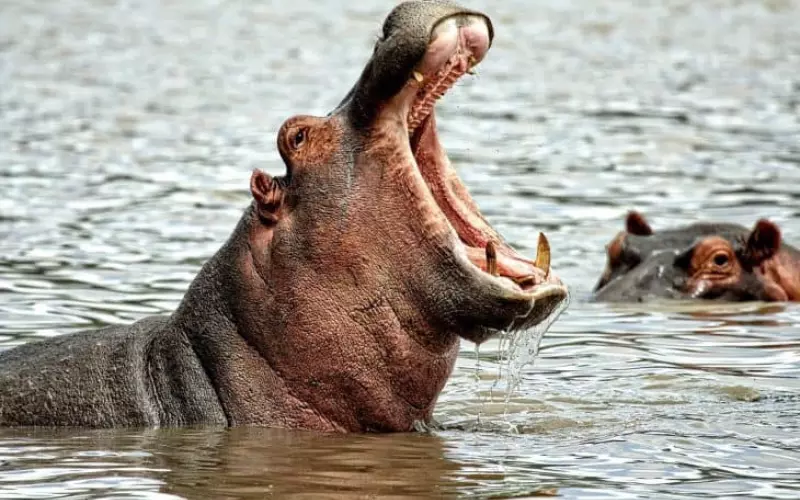
Hippopotamus, also known as the “river horse,” belongs to the animal kingdom, specifically the phylum Chordata. They are classified under the class Mammalia, which means they are mammals. This means that they have hair or fur and give birth to live young ones, just like humans.
In the order Artiodactyla, hippopotamuses belong to the family Hippopotamidae and genus Hippopotamus. They are the third largest land mammals on Earth, after elephants and rhinoceroses. Hippopotamuses are further divided into two species: the common hippopotamus (Hippopotamus amphibius) and the pygmy hippopotamus (Hexaprotodon liberiensis).
Hippopotamuses have distinct features that help them adapt to their watery habitat. They have massive bodies, stubby legs, and a large mouth filled with sharp teeth. They spend most of their time in the water to keep cool, only coming out at night to graze on land. Despite their large size, they are surprisingly agile and can move quickly both in water and on land.
Hippopotamuses are fascinating animals classified under the class Mammalia. They are known for their enormous bodies and semi-aquatic lifestyle. It is always interesting to learn about the different species that exist in our animal kingdom, and the hippopotamus is definitely one of the most remarkable creatures out there.
Different Types of Hippopotamus
1. Common Hippopotamus: The most well-known type of hippopotamus, it is found in sub-Saharan Africa. Known for their large size and aggressive behavior, they are herbivores and spend most of their time in water but can often be seen on land.
2. Pygmy Hippopotamus: Smaller in size compared to the common hippo, this species is native to West Africa. They have a more slender body and spend less time in water. They are mainly herbivores and are considered an endangered species.
3. Madagascar Dwarf Hippopotamus: This unique type of hippopotamus is only found in Madagascar. They are much smaller than common hippos and have adaptations for an aquatic lifestyle. They have a semi-aquatic behavior and are herbivores.
4. Malagasy Hippopotamus: Another special type of hippo found only in Madagascar, this species is extinct. It lived in rivers and lakes, though its exact appearance is still unclear due to limited fossil evidence. The cause of their extinction is believed to be due to environmental changes.
5. European Hippopotamus: Now extinct, this species once roamed across Europe but went extinct around 30,000 years ago. They had adaptations to survive in a colder climate, with a thicker coat and shorter limbs compared to other hippos.
6. The Word “Hippopotamus”: Although not referring to a specific type of hippo, the word “hippopotamus” originates from the ancient Greek language and means “river horse.” It aptly describes these semi-aquatic mammals due to their large size and their tendency to wade or swim in rivers and lakes.
7. Semi-aquatic Lifestyle: Hippopotamuses are well adapted to both land and water environments. Spending most of their time submerged, they have a special layer of mucus that keeps their skin moisturized and prevents it from drying out.
8. Herbivorous Diet: Hippos mainly feed on grasses and other plant material, consuming around 80 pounds of vegetation per day. Their powerful jaws and sharp teeth help them to graze on plants and chew their food efficiently.
9. Protective Mothers: Female hippos are known for being fiercely protective of their young calves. They stay close to their offspring, defending them from any potential predators. This maternal behavior ensures the survival of their young ones.
10. Conservation Concerns: Several types of hippos, such as the pygmy hippo, are classified as endangered or vulnerable, mainly due to habitat loss and illegal hunting for their meat and ivory. Conservation efforts are crucial to protect these magnificent creatures and maintain their populations in the wild.
Geographical Presence of Hippopotamus
Hippopotamuses, also known as hippos, are found in the sub-Saharan region of Africa. This means they can be seen in countries such as Kenya, Tanzania, Uganda, Sudan, and other nearby countries. Hippos love to live near rivers, lakes, and swamps, as they spend most of their time in the water to keep cool and protected from the hot sun.
On the other hand, you won’t find hippos living in places like Europe, Asia, or the Americas. These regions are very different from the natural habitats of hippos, and they require specific environments to survive and thrive. Hippos need a lot of water, plenty of vegetation to eat, and warm climates, which are usually found in Africa’s sub-Saharan region.
Additionally, it’s important to note that hippos are not found in every part of Africa either. They are usually absent from the desert regions of the continent, such as the Sahara Desert. These arid areas lack the necessary water sources and greenery that hippos rely on. So, if you ever go on a safari or travel to Africa, make sure to visit the sub-Saharan countries to have a chance to see these magnificent creatures!
Overall, hippos are fascinating animals that can only be found in the sub-Saharan region of Africa. They are not present in Europe, Asia, or the Americas, nor in arid deserts like the Sahara. With their love for water and abundance of vegetation, these unique animals have carved out their niche in the beautiful landscapes of Africa’s rivers, lakes, and wetlands.
Diet of Hippopotamus
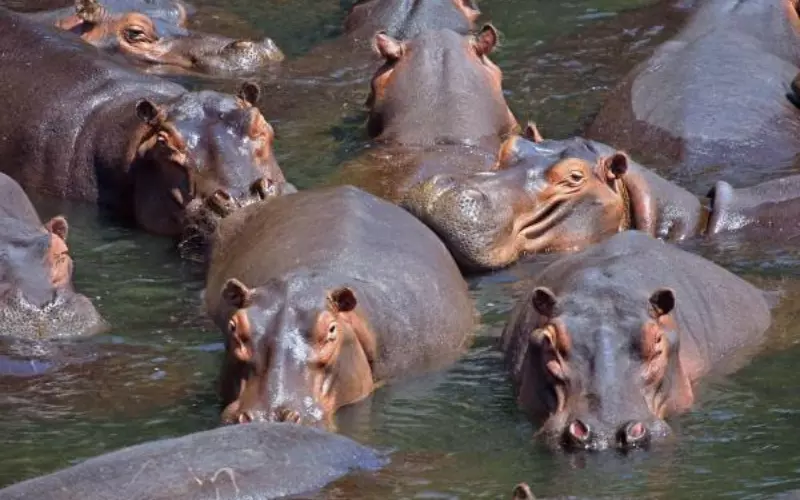
The hippopotamus, also known as the hippo, is a large mammal that lives in Africa. These animals are herbivores, which means they eat only plants and not meat. Their diet mostly consists of grass, but they also eat other types of plants that grow near water.
Hippopotamuses are very big and need to eat a lot to stay healthy. They can consume about 80 pounds of food in just one night! To find their food, hippos venture out of the water and walk on land, searching for patches of grass. They have big mouths and strong jaws that help them easily tear and chew the plants they find.
Water is another important part of a hippo’s diet. They spend a lot of time in rivers, lakes, and swamps because they need to stay hydrated. Hippos have special adaptations that allow them to stay in the water for long periods. They even have a layer of oily sweat that helps protect their skin from the sun.
Hippos are herbivores that eat plants and grass to survive. They also need water to stay hydrated and spend much of their time in rivers and lakes. These incredible creatures have adapted to their environment to ensure they have enough food and water to meet their dietary needs.
Locomotion of Hippopotamus’s
Hippopotamus, also known as hippos, move in a unique way. They are bulky animals with small legs. These legs may look stubby, but they are very strong and help the hippos move around in water and on land. When in water, hippos use their legs to push off the river or lakebed and swim gracefully. Despite their large size, they are quite fast swimmers, able to reach speeds of up to 19 miles per hour (30 kilometers per hour)!
On land, hippos use their legs to walk and run. They have a distinctive gait, where they move both legs on the same side of their body at the same time. This is called a lateral sequence walk. It may look a bit unusual, but it helps hippos distribute their weight evenly, allowing them to move with stability. With each step, their webbed toes spread out, giving them a better grip on the ground. Although they may not be the fastest runners, they can still reach speeds of up to 18 miles per hour (30 kilometers per hour). This helps them escape from dangers or simply get from one feeding area to another.
Hippos have an interesting way of moving around. Whether they are swimming or walking on land, their strong legs and unique gait allow them to navigate their surroundings with ease. Despite their seemingly awkward appearance, hippos are surprisingly agile and fast, making them fascinating creatures to observe.
Social and Sexual Behaviour of Hippopotamus’s
Hippopotamuses, also known as hippos, have interesting social behaviors. They live in groups called schools, which can consist of 10 to 30 individuals. These schools usually have a dominant male hippo, who protects his territory and mates with female hippos. Other male hippos in the school are usually younger and wait until they are strong enough to challenge the dominant male. Hippos communicate with each other through grunts, bellows, and body gestures. They also mark their territories with dung and urine.
When it comes to sexual behavior, hippos have a unique approach. Male hippos attract females by displaying their dominance. They do this by opening their huge mouths wide and revealing their sharp teeth. This is called a “yawn display.” Female hippos show their interest by approaching the male and allowing him to sniff her rear end. After this, the male and female will mate in the water, where the female usually gives birth to a single calf after a gestation period of about eight months. Hippos have a strong bond with their young ones and will protect them fiercely from any danger.
Hippos are social creatures that live in groups and have unique ways of communicating with each other. Their sexual behavior involves displays of dominance from males to attract females. They mate in the water and have strong bonds with their offspring. Hippos truly have fascinating social and sexual behavior that showcases their incredible nature.
Reproduction and Lifecycle of Hippopotamus’s
Hippopotamuses, or hippos as they are often called, have a fascinating life cycle. In order to reproduce, a male hippo finds a female hippo that he wants to mate with. He attracts her by showing off his strength and size. If the female is interested, she will allow the male to mate with her. These powerful creatures usually mate in water, where the male can push the female under the water to protect her from other males that may try to interrupt the process.
After a gestation period of about eight months, the female hippo gives birth to a single calf. The baby is born in shallow water and is usually assisted by the mother and other females from the herd. It is a very special moment, as the entire herd celebrates the arrival of the newborn. The calf weighs around 100 pounds at birth and is able to swim immediately. It relies on its mother for milk, but it will start eating vegetation after a couple of weeks.
As the calf grows, it lives a rather independent life. At around three years old, it will be fully matured and ready to find a mate. Female hippos reach sexual maturity a bit earlier, at about five years old. This marks the beginning of a new life cycle for them as they start the process of finding their own mate and creating the next generation of hippos. It’s a truly remarkable journey from birth to adulthood for these extraordinary animals.
Threats to Hippopotamus’s
Hippopotamus are facing several threats that could affect their survival. One major threat to these animals is habitat loss. Due to urbanization and agriculture, many of the areas where hippos used to roam freely have been converted into cities or farmland. This means that hippopotamuses have less space to live and find food, which can have a negative impact on their population.
Illegal hunting is another significant threat to hippopotamus. People hunt these animals for their meat, ivory tusks, and skin. This not only reduces the number of hippos in the wild but also disrupts their social structures and natural balance in their ecosystems. Furthermore, the hunting of hippos can also lead to the spread of diseases among their populations.
Pollution is also harming hippos and their habitats. Water pollution caused by agricultural runoff and industrial waste can contaminate the rivers and lakes where hippos live. This pollution can affect their health and lead to the decline of their populations. Additionally, the destruction of vegetation due to pollution can reduce the availability of food for hippos and other animals that depend on these ecosystems.
In order to protect hippos, it is important to take action against these threats. This can be done by supporting conservation organizations that work to preserve their habitats, as well as by enforcing laws against illegal hunting. Additionally, efforts should be made to reduce pollution and promote sustainable agriculture practices to safeguard the health of hippos and their ecosystems.
Conclusion
The hippopotamus is a fascinating animal with a rich history and many interesting facts. These hefty creatures once roamed the earth alongside some of the largest dinosaurs. They have adapted to different environments over the years and are now mainly found in sub-Saharan Africa. Despite their large size, they are capable of swimming and spending a significant amount of time in water.
Hippopotamuses are known for their impressive size, often weighing up to 3,000 kilograms. They prefer to live in rivers, lakes, and swamps, where they can comfortably cool off during the hot African days. Their classification as mammals places them in the same group as other animals that give birth to live young and produce milk to nourish them. The hippo’s closest relatives are whales and dolphins.
The hippopotamus is a fascinating creature that has captured the attention of humans for centuries. From their ancient history to their impressive size and unique habitat requirements, there is much to learn about these magnificent animals. They serve as a reminder of the diversity and wonder of the animal kingdom and the importance of protecting all species for future generations to enjoy.
FAQ’s
What is a hippopotamus?
A hippopotamus is a large herbivorous animal native to sub-Saharan Africa.
How big can a hippopotamus get?
Adult hippos can typically weigh between 1.5 to 4 tons and stand around 4 to 5 feet tall.
What is the lifespan of a hippopotamus?
In the wild, hippos can live up to 40-50 years, although they can reach their 60s when in captivity.
Are hippos dangerous?
Yes, hippos are considered one of the most dangerous animals in Africa and can be extremely territorial and aggressive.
What do hippos eat?
Hippos are herbivores and primarily eat grass, but they can also consume fruits and occasionally small amounts of aquatic plants.
Can hippos swim?
Yes, hippos are excellent swimmers and are capable of holding their breath for up to 5 minutes while submerged.
Do hippos live in water?
Hippos are semi-aquatic animals and spend a significant amount of time in water, mainly to keep their bodies cool and protect their skin from the sun.
How fast can hippos run?
Despite their size, hippos can run surprisingly fast and reach speeds of up to 20 miles per hour over short distances.
Are hippos endangered?
Yes, hippos are currently classified as “vulnerable” due to habitat loss, illegal hunting, and poaching for their ivory teeth.
How do hippos communicate with each other?
Hippos communicate through vocalizations, including a wide variety of grunts, roars, and snorts, as well as body language and visual displays.
Can hippos be domesticated?
No, hippos are highly aggressive and territorial animals, so they cannot be domesticated or kept as pets.
Do hippos have any natural predators?
While adult hippos have few natural predators, young calves are vulnerable to attacks from lions, crocodiles, and hyenas.
Can hippos breathe underwater?
No, hippos cannot breathe underwater. They need to come to the water’s surface to breathe using their nostrils.
How many species of hippos exist?
There are two species of hippos: the common hippopotamus (Hippopotamus amphibius) and the pygmy hippopotamus (Choeropsis liberiensis).
Are hippos social animals?
Yes, hippos are social animals and live in groups called pods or bloats that can consist of up to 30 individuals.

Hi there! I’m Morgan Gutierrez, and I love animals! I work as a Seasonal Animal Care Specialist at Brookfield Zoo and also teach people about animals, which is super fun. I studied at Valparaiso University in Lockport, Illinois, where I learned even more about these amazing creatures.
I’m not just about taking care of animals; I write articles about them, too! I explore and share many interesting animal stories, from cute kittens to giant elephants.
In the past, I’ve worked with veterinarians, helped with research, and even been an Animal Ambassador, bringing animals closer to people. Animals are my passion, and I enjoy helping others learn about them. So, if you ever want to know about animals, feel free to ask. I’ll explain it in a way that’s easy to understand, just like talking to a friend!

